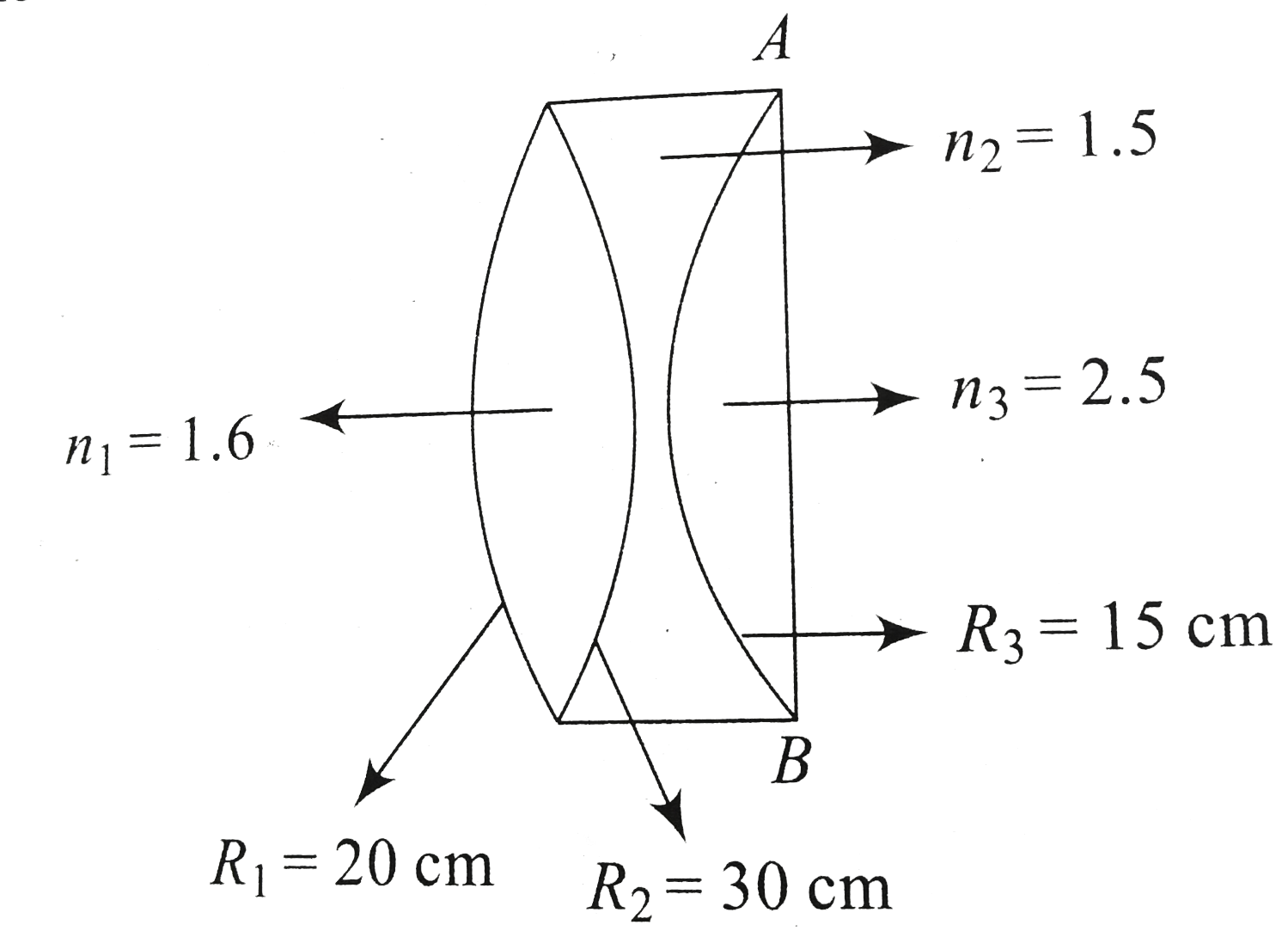An object is placed at 10 cm from a lens and real image is formed with magnification of 0.5. Then the lens is
concave with focal length of 10/3 cm
convex with focal length of 10/3 cm
concave with focal length of 10 cm
convex with focal length of 10 cm
The correct Answer is:B
To solve the problem, we will follow these steps:
Step 1: Identify the given values
- The object distance (u) is given as 10 cm. Since the object is placed in front of the lens, we take it as negative in lens formula:
u=−10cm
- The magnification (m) is given as 0.5.
Step 2: Use the magnification formula
The magnification (m) for a lens is given by the formula:
m=h′h=−vu
Where:
- h′ is the height of the image,
- h is the height of the object,
- v is the image distance,
- u is the object distance.
Given that m=0.5, we can rearrange the magnification formula to find v:
0.5=−v−10
This simplifies to:
v=0.5×10=5cm
Step 3: Apply the lens formula
The lens formula is given by:
1f=1v−1u
Substituting the values of v and u:
1f=15−1−10
This can be rewritten as:
1f=15+110
Step 4: Find a common denominator and solve for f
The least common multiple of 5 and 10 is 10. Thus:
1f=210+110=310
Now, taking the reciprocal to find f:
f=103cm
Step 5: Determine the type of lens
Since the focal length f is positive, we conclude that the lens is a convex lens.
Final Answer
The lens is a convex lens with a focal length of 103cm.
---
- The object distance (u) is given as 10 cm. Since the object is placed in front of the lens, we take it as negative in lens formula:
u=−10cm
- The magnification (m) is given as 0.5.
The magnification (m) for a lens is given by the formula:
m=h′h=−vu
Where:
- h′ is the height of the image,
- h is the height of the object,
- v is the image distance,
- u is the object distance.
0.5=−v−10
This simplifies to:
v=0.5×10=5cm
The lens formula is given by:
1f=1v−1u
Substituting the values of v and u:
1f=15−1−10
This can be rewritten as:
1f=15+110
The least common multiple of 5 and 10 is 10. Thus:
1f=210+110=310
Now, taking the reciprocal to find f:
f=103cm
Since the focal length f is positive, we conclude that the lens is a convex lens.
The lens is a convex lens with a focal length of 103cm.
Topper's Solved these Questions
- RAY OPTICSBook:DC PANDEY ENGLISHChapter:RAY OPTICSExercise:Checkpoint 9.5
Explore 10 Videos
- RAY OPTICSBook:DC PANDEY ENGLISHChapter:RAY OPTICSExercise:Checkpoint 9.6
Explore 20 Videos
- RAY OPTICSBook:DC PANDEY ENGLISHChapter:RAY OPTICSExercise:Checkpoint 9.3
Explore 20 Videos
- NUCLEIBook:DC PANDEY ENGLISHChapter:NUCLEIExercise:C MADICAL ENTRANCES GALLERY
Explore 46 Videos
- REFLECTION OF LIGHTBook:DC PANDEY ENGLISHChapter:REFLECTION OF LIGHTExercise:Subjective
Explore 9 Videos
Similar Questions
When an object is placed 15cm from a lens, a virtual image is formed. Mark the correct statements.
View SolutionWhen an object is placed 40cm from a diverging lens, its virtual image is formed 20cm from the lens. The focal length and power of lens are
View SolutionA lens is made of three thin different mediums. Radius of curvature and refractive index of each medium is shown iin Figure., Surface AB is straight. An object is placed at some distance from the lens by which a real image is formed on the screen placed at a distance of 10cm from the lens. Find the distance of the object from the lens.

View SolutionWhen a real object is placed 25cm from a lens, a real image if formed. Mark the correct statement(s) from the following:
View SolutionA point object is placed at a distance of 15 cm from a convex lens. The image is formed on the other side at a distance of 30 cm from the lens. When a concave lens is placed in contact with the convex lens, the image shifts away further by 30 cm. Calculate the focal lengths of the two lenses.
View SolutionA convex lens is used to obtain a magnified image of an object on a screen . The object is at a distance 10 m from the lens . If the magnification is 19. the focal length of the lens is
View SolutionA linear object is placed on the axis of a lens. An image is formed by refraction in the lens. For all positions of the object on the axis of the lens, the positions of the image are always between the lens and the object.
(i) Name the lens.
(ii) Draw a ray diagram to show the formation of the image of an object placed in front of the lens at any position of your choice except infinity.
View SolutionA concave lens has focal length of 15 cm. At what distance should an object from the lens be placed so that it forms an image at 10 cm from the lens ? Also, find the magnification of the lens.
View SolutionA convex lens produces an image of a real object on a screen with a magnification of 1/2. When the lens is moved 30 cm away from the object, the magnification of the image on the screen is 2. The focal length of the lens is
View SolutionAn object is kept at a distance of 16cm from a thin lens and the image formed is real. If the object is kept at a distance of 6cm from the lens, the image formed is virtual. If the sizes of the images formed are equal, the focal length of the lens will be
View Solution

